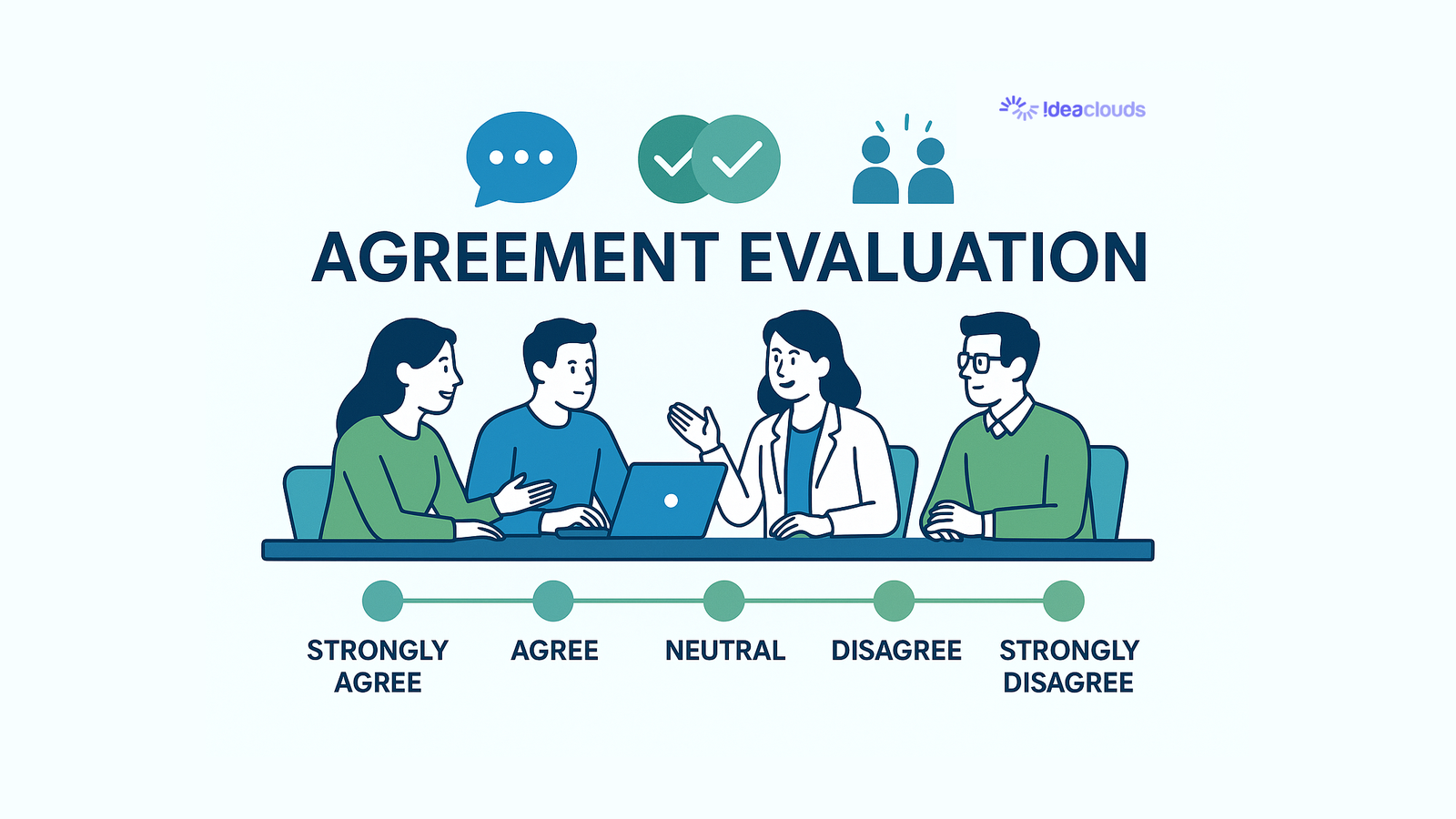Part of the Multi-Criteria Evaluation & Prioritization Framework
This guide covers Anonymous Agreement Evaluation—a single-criterion technique for building consensus. For the complete framework including multi-criteria evaluation, scoring, aggregation methods, and choosing the right approach for your context, see the full framework guide.
Anonymous Agreement Evaluation: Workshop Techniques for Digital Team Consensus

Anonymous agreement evaluation is a powerful technique for multi-criteria evaluation and prioritization. When teams need to evaluate proposals using Agreement as an evaluation criterion, this technique captures authentic opinions: strongly agree, agree, neutral, disagree, strongly disagree.
What is Anonymous Agreement Evaluation?
Anonymous agreement evaluation is a digital workshop facilitation technique that allows team members to express their level of agreement with proposals, ideas, or decisions without public pressure. This anonymous agreement evaluation method captures authentic opinions first, then uses aggregated results to guide targeted conversations only where genuine disagreement exists.
Agreement as a Flexible Evaluation Criterion
Agreement is one of many evaluation criteria teams can choose when making decisions. Unlike rigid frameworks that force every decision through the same lens, multi-criteria evaluation framework for each specific decision context.
Common evaluation criteria include:
- Agreement: How much consensus exists among team members
- Impact: Expected business value or user benefit
- Effort: Time, resources, and complexity required (effort vs benefit analysis)
- Feasibility: Technical viability and constraints
- Risk: Potential downsides and failure scenarios (risk identification)
- Urgency: Time sensitivity and market timing
When to prioritize Agreement as your evaluation criterion:
- Cross-functional decisions where buy-in determines implementation success
- Strategic direction changes that require organizational alignment
- Resource allocation affecting multiple teams or departments
- Process changes that people must actively adopt
- Cultural initiatives dependent on collective commitment
Agreement matters most when lack of consensus creates implementation resistance. A technically perfect decision with 40% team agreement often fails, while a good-enough decision with 90% agreement succeeds because people actively support execution.
Teams using flexible criteria often combine Agreement with other criteria for comprehensive evaluation. For example, multi-criteria decision making might evaluate product features on both Agreement (will the team support this?) and Impact (will customers value this?). This reveals opportunities where high agreement meets high impact, and flags concerns where the team agrees on low-value work.
When should you use the agreement evaluation technique?
Use anonymous agreement evaluation in these specific scenarios:
- Team alignment meetings where members may hesitate to voice disagreement publicly
- Project kick-off workshops to validate assumptions before resource allocation
- Strategic planning sessions involving multiple departments with competing interests
- Remote workshops where reading non-verbal cues is difficult
- Cross-functional collaboration with participants from different organizational levels
This technique works best when facilitators need to separate genuine disagreements from social pressures that prevent honest feedback.
What are the benefits of using the agreement evaluation technique?
Anonymous agreement evaluation delivers meaningful improvements in workshop outcomes:
- Faster consensus building: Teams reach alignment more quickly when they know where real disagreement exists
- Higher implementation success: Decisions with documented team agreement have better follow-through
- Improved psychological safety: Team members feel comfortable expressing concerns without fear of confrontation
- Better decision quality: Anonymous input reveals hidden objections that would surface during implementation
- Equal participation: Introverted team members and junior staff contribute equally to decision-making
When all team members genuinely agree on the path forward, projects move faster because resistance has been addressed upfront rather than discovered during execution.
How to Use Anonymous Agreement Evaluation in Workshops
- Select the anonymous agreement evaluation technique and start a new IdeaClouds session for digital team consensus building
- Write down your ideas, suggestions, proposals, goals, etc. on the workspace
- Let the team members add their ideas etc.
- Start the evaluation phase and let the team members evaluate the ideas according to agreement
- Finish the evaluation phase and discuss the ideas with little agreement, which are further down in the ranking on the result page
Advanced Anonymous Agreement Evaluation Techniques
Experienced workshop facilitators enhance anonymous agreement evaluation with these proven consensus-building approaches:
Multi-Round Evaluation
After addressing concerns from the first round, conduct a second anonymous evaluation to measure improvement in team alignment. This iterative approach helps teams refine proposals based on feedback.
Integration with Other Methods
Combine agreement evaluation with effort/benefit analysis and ranking techniques for comprehensive decision-making.
Measuring Success
Track these metrics to demonstrate the value of anonymous agreement evaluation:
- Time to consensus: Compare workshop duration before and after implementing anonymous evaluation
- Implementation follow-through: Measure what percentage of decisions are actually executed
- Team satisfaction: Survey participants on workshop effectiveness and feeling heard
Getting Started with Anonymous Agreement Evaluation
Start another session to improve the ideas with little agreement or develop alternative ideas as a team.
Anonymous agreement evaluation transforms how teams make decisions by revealing genuine alignment while protecting psychological safety. This digital facilitation technique helps organizations build stronger consensus and achieve faster project implementation.
Agreement is Just One of Many Flexible Criteria
Anonymous Agreement Evaluation works best when combined with other evaluation criteria like Impact, Effort, and Risk. Discover why enterprises are moving away from rigid frameworks to flexible criteria that adapt to each decision context.